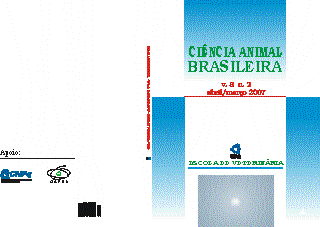AUTUMNAL FORAGE YIELD AND NUTRITIVE VALUE OF THE LEGUME ARACHIS
DOI:
https://doi.org/10.5216/cab.v8i3.1676Keywords:
Forragem, valor nutritivoAbstract
Dry matter yield and nutritive value of forage le-gume Arachis pintoi (Krap. & Greg.) cv. Alqueire-1 (BRA 037036), was evaluated under different cutting mana-gement regimes and levels of P and K fertilization, in a yellow-red argisoil, at CAP-UFPEL, Capão do Leão, RS, Brazil during Spring-Summer and Fall. Cutting regimes compared were: no cutting, one, two, three, four and five cuttings, at 5 cm above ground. Fertilization levels con-sisted in supplying zero, 50 and 100% of requirements for P and K recommended by Brazilian Soil Science Society, for warm season perennial forage legumes. Fertilization treatments were alocated to main plots and cutting regi-mes to subplots, in a complete splitplot randomized block design, with three replications. Data of the following va-riables were submitted to analysis of variance and polino-mial regression: dry matter yield and quality of autumnal cutting, dry matter accumulation rate of autumnal cutting and total dry matter yield. If the purpose is the utilization of the forage during Autumn, 70% of the recommended phosphorus and potassium fertilization is sufficient to ob-tain maximum forage yield. However, if the objective are cuttings during the growing season (Spring-Summer) and also in Autumn, it is necessary 100% of the recommended fertilization. The increase in number of cuttings during Spring-Summer decreases in the same proportion the fo-rage yield in Autumn. Forage nutritive value in Autumn is better when greater number of cuttings are made during Spring-Summer. Spring deferments also result in higher autumnal forage quality.
KEY-WORDS: Cutting, fertilization, tropical forage.
Downloads
Downloads
Published
How to Cite
Issue
Section
License
Authors who publish with this journal agree to the following terms:
- Authors retain copyright and grant the journal right of first publication with the work simultaneously licensed under a Creative Commons Attribution License that allows others to share the work with an acknowledgement of the work's authorship and initial publication in this journal.
- Authors are able to enter into separate, additional contractual arrangements for the non-exclusive distribution of the journal's published version of the work (e.g., post it to an institutional repository or publish it in a book), with an acknowledgement of its initial publication in this journal.
- Authors are permitted and encouraged to post their work online (e.g. in institutional repositories or on their website) prior to and during the submission process, as it can lead to productive exchanges, as well as earlier and greater citation of published work (See The Effect of Open Access).




























